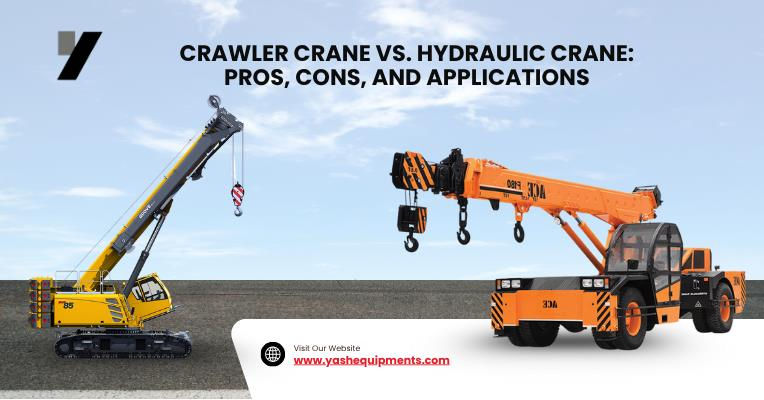Crawler Crane vs Hydraulic Crane: Pros, Cons, and Applications
- tarunk3
- Oct 17
- 4 min read

When it comes to lifting heavy loads in construction and industrial projects, choosing the right crane can make a huge difference in efficiency, safety, and cost. Two of the most popular types of cranes in the market are Crawler Cranes and Hydraulic Cranes. Both have unique strengths and limitations, and understanding them can help project managers and contractors make the right choice for their specific needs.
In this blog, we’ll compare Crawler Cranes and Hydraulic Cranes, discuss their pros and cons, and explore their applications to help you make an informed decision.
What is a Crawler Crane?
A Crawler Crane is a type of mobile crane that moves on tracks instead of wheels. Its design allows it to lift extremely heavy loads and operate on soft or uneven ground. Unlike some cranes, crawler cranes are equipped with a counterweight system and a lattice boom, which provides stability and makes them suitable for long-term heavy lifting tasks.
Key Features of Crawler Cranes:
Equipped with tracks for movement on rough terrain.
Can lift very heavy loads, sometimes exceeding 1,000 tons.
Offers excellent stability thanks to its wide base and counterweight.
Typically used for long-term construction projects.
What is a Hydraulic Crane?
A Hydraulic Crane, also known as a telescopic or truck-mounted crane, uses hydraulic systems to lift loads. The boom of a hydraulic crane can extend and retract, giving it flexibility and ease of operation. These cranes are generally mounted on wheels or trucks, making them highly mobile and versatile.
Key Features of Hydraulic Cranes:
Uses hydraulic systems for lifting and lowering.
Boom is telescopic, allowing variable reach.
Often mounted on trucks, making transportation easy.
Can operate efficiently in urban and industrial environments.
Crawler Crane vs Hydraulic Crane: Side-by-Side Comparison
Feature | Crawler Crane | Hydraulic Crane |
Mobility | Moves on tracks, slow but stable | Mounted on trucks, highly mobile |
Load Capacity | Very high, suitable for heavy lifting | Moderate to high, depends on model |
Terrain | Can work on uneven and soft ground | Best on firm, paved surfaces |
Setup Time | Longer setup due to assembly | Quick setup, often ready to lift immediately |
Lifting Height | Can reach very high heights with lattice boom | Limited by telescopic boom length |
Cost | Higher purchase and maintenance cost | Lower than crawler cranes |
Applications | Large construction, industrial projects | Urban construction, small to medium projects |
Pros and Cons of Crawler Cranes
Pros:
High Lifting Capacity: Crawler cranes can lift extremely heavy loads that hydraulic cranes cannot.
Stability: Tracks and counterweights provide unmatched stability, even on uneven terrain.
Durability: Built for long-term heavy-duty operations.
Flexibility in Large Projects: Ideal for major construction projects like bridges, power plants, and high-rise buildings.
Cons:
Slow Movement: Crawlers move slowly compared to truck-mounted hydraulic cranes.
High Cost: Both initial purchase and maintenance costs are significant.
Complex Setup: Assembly and disassembly require more time and skilled labor.
Space Requirement: Needs a larger area to operate and maneuver.
Pros and Cons of Hydraulic Cranes
Pros:
High Mobility: Can quickly move between job sites.
Fast Setup: Easy to deploy and start lifting immediately.
Versatility: Suitable for a wide range of lifting tasks.
Compact Design: Can operate in urban or congested environments.
Cons:
Lower Load Capacity: Cannot handle ultra-heavy loads like crawler cranes.
Limited Terrain Adaptability: Not suitable for very soft or uneven ground.
Stability Issues: May require outriggers for balance, especially with heavy loads.
Maintenance Needs: Hydraulic systems require regular maintenance to avoid failures.
Applications of Crawler Cranes
Crawler cranes are widely used in projects that require heavy lifting and stability over extended periods. Some common applications include:
Large Construction Projects: Bridges, high-rise buildings, dams, and industrial plants.
Heavy Lifting: Moving massive machinery, steel structures, or concrete segments.
Long-Term Projects: Projects where cranes need to operate continuously for months.
Challenging Terrains: Soft soil, marshy areas, or uneven construction sites.
Applications of Hydraulic Cranes
Hydraulic cranes are ideal for projects requiring flexibility, speed, and moderate lifting capacities. Typical applications include:
Urban Construction: Building small to medium-sized structures in cities.
Roadwork and Infrastructure Projects: Lifting materials on highways, bridges, and tunnels.
Event Setup: Lifting stages, lighting rigs, or heavy equipment for events.
Industrial Maintenance: Loading/unloading machinery in factories or warehouses.
How to Choose Between a Crawler Crane and Hydraulic Crane?
Choosing the right crane depends on your project requirements, site conditions, and budget. Here are some tips:
For heavy, long-term projects: A crawler crane is more suitable.
For urban or short-term projects: A hydraulic crane is the better option.
If terrain is uneven or soft: Opt for a crawler crane.
If mobility and quick setup are priorities: Go for a hydraulic crane.
At Yash Infra Equipments, we provide a range of crawler and hydraulic cranes tailored to various project needs. Our team can help you choose the right crane that maximizes efficiency, safety, and ROI.
Conclusion
Both crawler cranes and hydraulic cranes have their unique advantages and disadvantages. While crawler cranes excel in heavy lifting and stability, hydraulic cranes offer flexibility, speed, and mobility. Understanding your project requirements, terrain, lifting capacity, and budget will help you make the right choice.
With the right crane from Yash Infra Equipments, you can ensure safe, efficient, and timely completion of your construction or industrial projects.
Invest in the right crane today and make your heavy lifting tasks easier and safer.



Comments